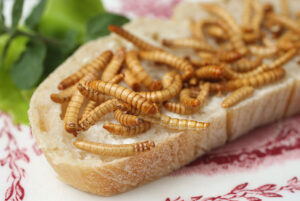A billowing concern of some on the left is the exhalation of CO2 and the expelling of methane by cows. The Klimate Kult is concerned by the effect of cow burps and farts on the oft-disproved “greenhouse” effect and the warming of the planet. Keep in mind that even if the planet is warming (and no uncorrupted global temperature data supports this), scientists are looking for a planet about five degrees C warmer than earth for future human habitation because a warmer planet has more food, less extreme weather and is a better home for humanity.
The solution to cow flatulence by some, including Bill Gates, the owner of more privately-owned farmland in the United States than anyone else, is for us to eat insects instead of food. Let’s say we replace food with bugs. To appease the Klimate Kult. To pretend against all evidence that Anthropogenic Global Warming exists. To signal our virtue to the universe. How many insects would we need to eat to replace beef... real food?
We would need to slaughter around 363,000 crickets to get the same number of calories that comes from one slaughtered cow. But we slaughter 1.5 billion cows every single year, meaning that to get the same number of calories that we get from all the cows we slaughter would mean around 550 trillion crickets would need to be slaughtered instead.
[I]t would be basically impossible to quantify how many insects would need to be killed to replace the other 70 billion land animals, and around 1.2 trillion marine animals, that are currently killed for animal products every single year.
But there's a problem. Something of which many are unaware, evidently, is that insects feel pain. Those same folks asking (demanding?) we reduce the human population of the planet to save it, are worried about the moral considerations of killing bugs. Oh, the humanity:
[I]n the case of crickets, they have been shown to react to receiving morphine, staying in a box that was getting progressively hotter for a longer period than the crickets who were not given morphine. After five days of being given morphine, they even started exhibiting signs of addiction when they were no longer given the opiate.
So whilst scientific knowledge on insect sentience is still in its early days, what we already know about these animals makes their lives morally valuable, and makes creating a system that would end up slaughtering an entirely incomprehensible number of them, a serious moral concern that we are ethically obligated to avoid.
Hmm… And how do we feed and water 550,000,000,000,000 crickets? And house them in such a way that they are healthy and that they successfully reproduce? And care for their pupae? And dispose of the waste of half-a-quadrillion crickets? How many concrete (which releases CO2) buildings would need to be built for housing and nurseries and abattoirs for these bugs? What would be the impact to waterways of this huge amount of concentrated waste?

Bon Appétit!
What would be the electrical cost of maintaining an insect habitat for hundreds of trillions of insects? Would the carbon footprint of these huge bugatoriums be larger than that of the food they are “replacing?” Does anyone know? It’s vanishingly rare for the left to do a cost-benefit calculation on their various emotional cults.
How would we consume these trillions of bugs?
Now, you can order insect protein bars and cricket flour on Amazon. For those with a sweet tooth, there are cricket flour chocolate chip cookies.
The beef industry in America, calf-to-table, employs about 900,000 Americans, is the 47th-largest industry in the U.S., producing $30.2 billion of fresh beef, $4.8 billion of ground beef, $11.6 billion of sirloin steak, at a growth rate of 3.2 percent annually in 2022.
As someone who has worked in the birthing of calves, who has herded, roped, cut, thrown and branded calves and yearlings, has milked cows and slaughtered beeves, I have a bias toward steaks and burgers. The iconic American cowboy never will be replaced in the mind of a boy or girl, or on a Hollywood screen, by a cricket wrangler. And, no, that independent lifestyle that much of the world admires and which those who have tried it find hard to give up, cannot be replaced by cricket ranches. But mine will be deemed an emotional and adolescent response to a global crisis…. that does not exist.
Will Bill Gates and his pals at the WEF get their tyrannical way, destroying the beef industry? Here’s an interesting thought: Elon Musk just offered a significant portion, 16 percent, of his billions to change an industry. Makes one think of Bill Gates and his desire for us to eat insects and fake meat.

Did somebody say "fake meat"?
In America in January of 2019, we had about 94,000,000 cattle. The average price In April, 2022, for a 750-lb steer was $1,150. Assuming about one-third of those 94 million cows are three-year-old, 750-lb steers, Gates could buy the entire 2022 American beef production for $35 billion, or about 27 percent of his wealth, leaving himself a paltry $100 billion to live on. If he also bought the entire crop of yearlings and 2-year-olds at half that price, he would spend a total of $61 billion, just under half of his wealth of $132 billion.
This is a future desired by Gates and his WEF cronies. Making us eat fake meat and insects instead of food. For no reason other than they can, we’d have no more beef.
Bill Gates Says He Will Force You to Eat Fake Meat
Bill Gates states that rich countries should give up all beef in favor of synthetic fake meat, a transition that can be supported by changing people's behaviors or enacting regulations to shift demand.
Think about that.
"... or enacting regulations" to make us eat bugs....
Then ask yourself this: Who or what is going to stop him?
Article tags: beef, Bill Gates, bugs, carbon emissions, climate change, crickets, Elon Musk, environmentalism, global warming
Bill Gates, et al won't be around forever. Take that to the bank.
and bugs emit methane as well ... termites emit 20 million tons of methane while cows only emit 2 million tons ... so I assume these other bugs emit methane as well ... most likely well in excess of what the cows emit ...